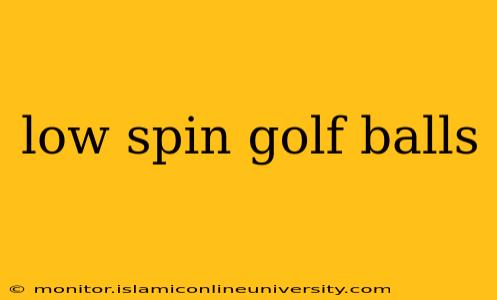Choosing the right golf ball can significantly impact your game. For players seeking increased distance and a straighter trajectory, low spin golf balls are often the preferred choice. But what exactly makes a low spin golf ball different, and are they right for you? This comprehensive guide will delve into the nuances of low spin golf balls, helping you understand their benefits, drawbacks, and how to choose the perfect one for your swing.
What Makes a Golf Ball Low Spin?
The key to a low spin golf ball lies in its design and construction. Several factors contribute to its lower spin rate compared to high-spin counterparts:
-
Dimples: The number, depth, and arrangement of dimples on a golf ball significantly affect its aerodynamics. Low spin balls often have fewer, shallower dimples, reducing drag and promoting a straighter flight.
-
Core: The core material and size impact the ball's compression and energy transfer. Low spin balls typically feature a larger, softer core, leading to lower spin off the driver and irons.
-
Cover: The cover material and its thickness play a critical role. Low spin golf balls often use a firmer, thinner cover, resulting in less spin on full shots. This is particularly noticeable on driver shots where high spin can lead to a loss of distance.
What are the Benefits of Using a Low Spin Golf Ball?
Low spin golf balls offer several advantages, particularly for players with higher swing speeds:
-
Increased Distance: Reduced spin off the tee translates to greater carry distance, a significant advantage for many golfers. This is because less backspin means the ball spends less time in the air, allowing gravity to pull it down to the ground faster.
-
Straighter Shots: Lower spin reduces the effect of sidespin, leading to straighter drives and longer irons. This is particularly helpful for players who struggle with slice or hook shots.
-
Better Roll: With less backspin, the ball will roll further upon landing, adding to the overall distance.
Who Should Use Low Spin Golf Balls?
Low spin golf balls are generally best suited for players with:
-
Higher Swing Speeds: These players generate enough clubhead speed to benefit from the reduced spin, maximizing distance.
-
A Strong, Consistent Swing: Low spin balls require a well-controlled swing to take full advantage of their characteristics. Inconsistent swings can lead to less predictable results.
-
Preference for Distance Over Control: Players prioritizing distance over pinpoint accuracy on approach shots will find these balls more beneficial.
Are Low Spin Golf Balls Right for Every Golfer?
No. While the benefits of low spin are appealing, they're not universally ideal. High-handicap golfers or those with slower swing speeds might find that low spin balls are less forgiving, leading to less control and potentially shorter shots. For these players, a higher spin ball may offer more control and better feel around the green.
What are the Drawbacks of Low Spin Golf Balls?
Despite their advantages, low spin golf balls have some limitations:
-
Less Control on Approach Shots: The reduced spin can make it harder to control the ball's trajectory and stopping power on approach shots, potentially leading to longer shots that stop short of the green or roll past the target.
-
Less Feel Around the Greens: The firmer cover typically used on low spin balls can reduce feel and responsiveness when chipping and putting, impacting short game accuracy.
-
Increased Sensitivity to Swing Mechanics: Inconsistent swing patterns can lead to less predictable ball flight.
How to Choose the Right Low Spin Golf Ball?
Choosing the right golf ball involves considering several factors:
-
Swing Speed: Measure your swing speed to determine if you'll benefit from a low spin ball.
-
Skill Level: Consider your consistency and overall game.
-
Course Conditions: The course's layout and conditions can impact the effectiveness of different golf ball types.
-
Personal Preferences: Ultimately, the best way to find the right ball is through personal testing and experimentation.
What are Some Examples of Popular Low Spin Golf Balls?
(Note: I cannot provide specific brand names or product links as per the instructions.) Many reputable golf ball manufacturers offer excellent low spin options. Research different brands and models, carefully examining their specifications and reviews before making a purchase.
How Does Compression Affect Low Spin Golf Balls?
Compression is a key factor in a golf ball's performance. Lower compression cores are generally found in low spin golf balls, which contribute to a larger distance off the tee. However, it’s important to note that the relationship isn’t strictly linear; other factors like core size and cover material also play significant roles.
This guide provides a comprehensive overview of low spin golf balls. Remember, finding the perfect golf ball is a personal journey. Experiment with different options to find the one that best suits your swing, skill level, and golfing goals.
